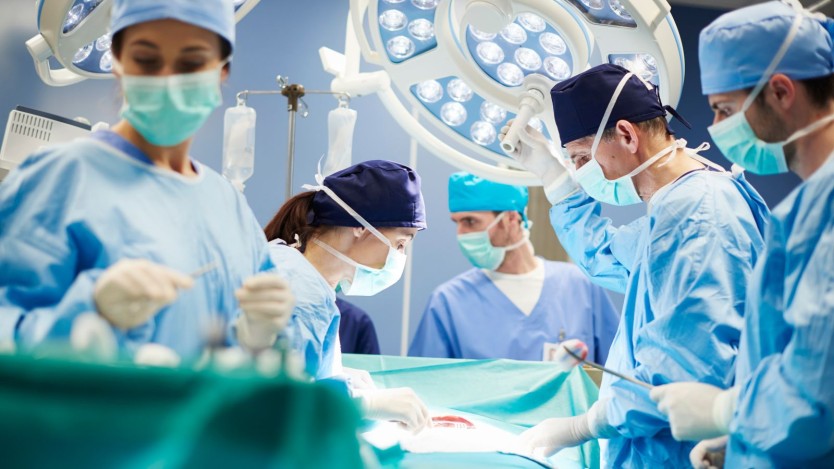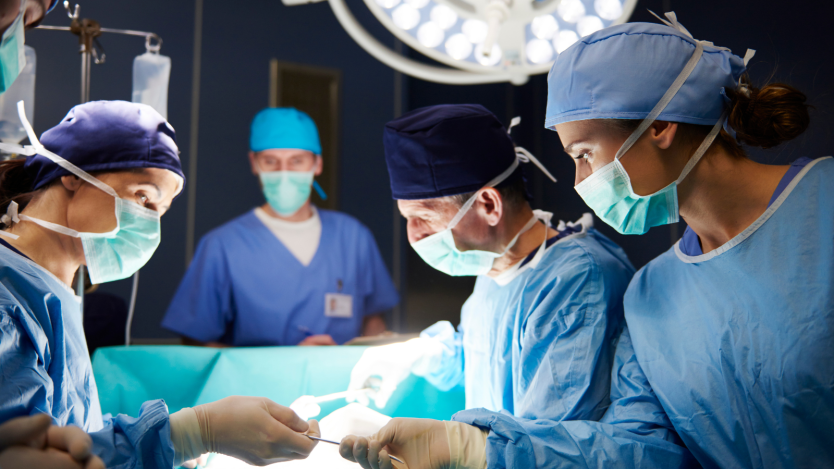Endoscopic Sinus Surgery (ESS): duration, cost and step by step

- What is an endoscopic sinus surgery?
- Why is endoscopic sinus surgery necessary?
- Preoperation study for endoscopic sinus surgery
- Endoscopic sinus surgery: step by step
- Duration of Endoscopic sinus surgery
- Cost of Endoscopic Sinus Surgery (nasal polyps, sinusitis)
- Request a surgical assessment consultation with the ENT specialist
- Endoscopic sinus surgery aims to restore normality to the mucosa by removing infections and clearing the sinuses.
- Sometimes sinusitis is solved with pharmacological treatments but this is not always effective and the only solution is a surgical procedure.
- The surgery lasts between 1 and 3 hours and is minimally invasive, so you can be back home the same day.
What is an endoscopic sinus surgery?
Endoscopic sinus surgery is a minimally invasive surgical procedure in which an intervention is performed in the nasal cavities and paranasal sinuses. This surgical intervention represents a major advance in the medical sector, as it has significantly reduced postoperative complications and discomfort.
The aim of this operation is to return the nasosinusal mucosa to normal. The drainage orifices are opened to eliminate infections and the sinuses are cleaned.
The surgery can be performed on an outpatient basis, that is, you can return home the same day of the intervention without the need for hospitalisation, although at Operarme, we include one day of hospitalisation for safety reasons.

Do you need surgery to eliminate nasal polyps?
Request a free and immediate appointment with our specialists in Otorhinolaryngology
This type of surgery is performed when sinusitis is chronic, nasal and sinus inflammation are permanent or nasal polyps appear, and even when sinusitis is acute but medical treatment has had no effect and the disease recurs continuously. In the following section we will explain a little more about why endoscopic sinus surgery is required.
Why is endoscopic sinus surgery necessary?
Endoscopic sinus surgery is performed when nasal and sinus inflammation are permanent and nasal polyps appear. In cases of acute sinusitis it is also often performed when medication has not solved the problem, the disease becomes chronic and symptoms persist for more than three months.
Sinusitis is a condition of the paranasal sinuses. These sinuses are air-filled cavities located in the bones of our skull that are responsible for filtering the air we inhale.
We will now explain why endoscopic surgery is necessary. In this case, we explain which nasal and sinus structures are affected by sinusitis.
- On the one hand we have the nostrils. These are the two cavities separated by the sagittal septum located above our mouth. Sinusitis can affect the different functions they have, such as filtering the air we breathe, distinguishing odours, collecting particles in the air or heating the air so that the lungs do not receive it cold.
- On the other hand, there are the four pairs of nasal cavities, called sinuses, which are located between the facial bones and the head. These cavities are responsible for draining the mucous fluid inside them, distributing the air that circulates through the respiratory tract and lubricating the nose, keeping it free of particles and bacteria. Sinusitis leads to a malfunction of the sinuses.
Reasons for undergoing surgery
When drugs do not work and the area remains inflamed and infected, it is common to resort to endoscopic sinus surgery. Thus, there are various reasons for deciding to have endoscopic sinus surgery and the patient is therefore characterised by one of the following conditions:
- Sinusitis, either acute or chronic. Sinusitis occurs when there is an increase of bacteria and germs in the sinuses causing a viral or bacterial infection. Sinusitis can be treated with medication, but if it is not treated correctly, it can go into remission. Therefore, if medication does not make the symptoms disappear, the only definitive solution is endoscopic sinus surgery.
- With the appearance of abnormal growths of the internal nasal tissue or mucosa that appear due to prolonged irritation or inflammation of the nose called nasal polyps. They are usually treated with nasal inhalers or pills to reduce their size, but, as in the case of sinusitis, surgical treatment is much more effective.
- Episodes of epistaxis. Nosebleeds are usually caused by trauma to the blood vessels on the surface of the nasal cavity, and it is when these are ruptured that blood leaks occur. With endoscopic sinus surgery, the correct functioning of the nasal passages is achieved and, with it, a clear improvement in the patient's life.
- Finally, with nasal and sinus tumours, the only solution is surgical treatment, regardless of the type or the aerodigestive area in which it is located.

Preoperation study for endoscopic sinus surgery
Once the consultation with an ENT specialist has taken place and a joint decision has been made to carry out the intervention, it is necessary to carry out a pre-operative assessment to determine whether the patient is a candidate for the intervention. In the case of Operarme, the time that normally elapses between the day of the assessment appointment with the specialist in Otorhinolaryngology and the moment of the intervention is approximately 7 to 10 days.
The time will be determined by the availability of the operating theatre and the completion of the pre-operative procedure.
In the case of endoscopic sinus surgery, a standard preoperative examination is performed, consisting of an electrocardiogram, blood tests and a chest x-ray (at the request of the doctor). On the other hand, it is possible that the specialist may request additional tests such as a computerised tomography. If this is the case, contact our patient service team and they will arrange it for you.
- Computerised tomography of the bones (CT scan): this test shows the anatomy of the paranasal sinuses, nasal cavities and possible abnormalities caused by the disease. It also detects the existence of mucoceles, nasal polyps, mucous content or bone conditions. This test must be paid for separately by the patient or provided by the patient. As we have indicated, if you have any questions, please contact our patient care team.
- Electrocardiogram: with this test, both the surgeon and the anaesthesiologist can find out about your cardiovascular health.
- Blood test: the purpose of this test is to confirm that you are not suffering from any abnormality or pathology, such as infections that could delay surgery until this is under control.
- Chest x-ray: this test is only performed if the doctor indicates it is appropriate and necessary. It is used to ensure that there is no infection in your trachea and to confirm that it is aligned for a possible and correct intubation.
Once the pre-operative period is over, a consultation will be arranged with the anaesthesiologist and, during this appointment, the specialist will determine whether you are suitable for endoscopic sinus surgery.
To do so, the surgeon will ask you a series of questions to find out about your lifestyle, what medication you are taking, what operations you have undergone previously and any other indications he/she deems appropriate to confirm your suitability.
Finally, the specialist will give you a series of indications prior to the surgery and all that remains is to attend the intervention.
Endoscopic sinus surgery: step by step
Endoscopic sinus surgery is a minimally invasive surgical procedure that can be performed on an outpatient basis, i.e. it is not necessary to be admitted to hospital, although it always depends on the surgeon's indications.
In this surgical procedure, the nasal cavities and paranasal sinuses, which are responsible for filtering air and distinguishing odours, as well as draining mucous fluid, respectively, are intervened in order to return the nasosinusal mucosa to normal.
This type of surgery lasts between 1 and 3 hours, depending on the complexity of each case, although this will be discussed in more detail in the following section.
The intervention is performed when the sinusitis is chronic and the nasal and sinus inflammation is permanent or nasal polyps appear, or even when the sinusitis is acute but the medical treatment has had no effect and the disease recurs continuously, as we have mentioned on more than one occasion throughout this article.
The aim of this procedure is therefore to restore the correct functioning of the sinuses with as little surgical invasion as possible.

We will now discuss the step-by-step procedure that we usually follow at Operarme for endoscopic sinus surgery, as this is the one we know best:
The four steps of surgery
When you arrive at the hospital, the first thing to do is to hand in all the relevant documentation at the admissions desk to gain access to the operating theatre area. Don't worry, the patient service team will have explained everything to you beforehand.
There, in the room before the operating theatre, you will be asked to dress in a surgical gown and you will be given a line through which the anaesthesia and necessary medication will be administered.
Once in the operating theatre, you will meet the surgeon, with whom you had previously had a consultation, the anaesthetist and a nurse.
Once you are there and on the stretcher, the operation will begin:
- First of all, the anaesthetist who attended to you in the pre-operative period will give you a general anaesthetic.
- To do so, the surgeon will use a nasal decongestant to reduce the swelling of the mucous membranes of the nasal passages.
- Once the inflammation has been reduced by the application of the drug, the nasal wall is dissected. For this purpose, a very fine rigid optical fibre is introduced into the nostril to obtain a clear view of the opening of the sinuses. Once there, the specialist will proceed to resect the abnormal or obstructive tissue with a special surgical instrument for this type of surgery.
- After removing the obstructive tissue, the surgeon will examine the bleeding sites and, depending on the situation, a nasal packing will be made to prevent bleeding, as well as silicone sheets to prevent adhesions from one wall to another or the formation of scars.
Once the operation is over, you will be taken to the post-surgery room where you will be monitored by the nursing team and the effects of the anaesthesia will gradually wear off. Depending on the complexity of the surgery, you may be discharged immediately, or you may remain in hospital for a day before returning home.
In the case of Operarme, unless the doctor indicates otherwise, the patient usually spends one night in hospital under surveillance.

Do you need surgery to eliminate nasal polyps?
Request a free and immediate appointment with our specialists in Otorhinolaryngology
Duration of Endoscopic sinus surgery
Endoscopic sinus surgery lasts approximately 1 to 3 hours. This depends on each case and the complexity of each intervention. In this operation, no external incisions are made, as they are performed through a camera with different angles. The camera is introduced through the nose and guided into the sinuses to clearly see obstructions and/or lesions.
Therefore, as we have already mentioned in other sections, in the vast majority of cases, this type of intervention means that the patient can go home the same day of the operation, although this always depends on the opinion of the specialist, who will assess it according to the complexity of the operation.

The hospital stay is usually one day under normal conditions, and the patient can return home the following day on their own.
In any case, it is important that the patient goes with a companion or requests the free transfer service that Operarme offers to return home on the day of discharge, as it is not advisable to drive immediately after surgery due to the inflammation of the operated area.
The operation is usually performed under general anaesthesia but can also be performed under local anaesthesia, sedation and patient analgesia. This, like every decision in surgery, will be at the discretion of the specialist.
Cost of Endoscopic Sinus Surgery (nasal polyps, sinusitis)
Endoscopic sinus surgery (nasal polyps, sinusitis) at Operarme includes everything necessary in the price to be able to carry out the surgery under the greatest possible safety and effectiveness for the patient.
We provide a fixed price at 4.890 € including all the necessary elements.
What does Endoscopic Nasosinus Surgery include?
Below we show you everything that is included in the cost of endoscopic sinus surgery at Operarme:
- Free surgical consultation.
- Stay in a single room with a spare bed and a full day's hospitality and linen service for the patient for 1 day.
- Booking and use of operating theatre.
- Surgical instruments, equipment and materials.
- Preoperative study (blood tests, electrocardiogram and chest x-ray according to medical indications).
- Stay in the post-surgical recovery room, monitoring and necessary treatments.
- Medical fees and fees for assistants until medical discharge.
- Anaesthesiologist fees.
- Medical complications insurance
Finally, the patient should not have to worry about anything other than his or her health and, for this reason, Operarme includes a service in its price in which the patient does not have to take the car or worry about transport.
A vehicle will pick you up at the company's expense on the day of your admission and will return you to your home once you have been discharged. You can find out more about this service by clicking here.
Request a surgical assessment consultation with the ENT specialist
You can request a free surgical assessment consultation with our ENT specialist to assess your particular case and then decide together which is the best option for your health issue.
You can request a surgical assessment consultation by clicking below:

Do you need surgery to eliminate nasal polyps?
Request a free and immediate appointment with our specialists in Otorhinolaryngology
Medical disclaimer: All the published content in Operarme is intended to disseminate reliable medical information to the general public, and is reviewed by healthcare professionals. In any case should this information be used to perform a diagnosis, indicate a treatment, or replace the medical assessment of a professional in a face to face consultation. Find more information in the links below:

